A Review of Exercise and Physical Activity for Chronic Back Pain
VerifiedAdded on 2023/01/06
|6
|2421
|30
Report
AI Summary
This report summarizes current evidence on the effects of exercise and physical activity on chronic back pain, a condition affecting millions of Australians and a significant portion of the global population. The report defines chronic back pain (CBP), explores its causes, and highlights the importance of lifestyle changes, injuries, and diseases. It reviews studies, including RCTs, systematic reviews, and literature reviews, to assess the effectiveness of various exercise interventions such as aerobic exercise, muscular strength, and stabilization exercises. The report includes findings from studies conducted in Australia, and evaluates the impact of different exercise programs. The report also discusses the benefits of physical activity, like aerobics, in increasing blood flow, reducing stiffness, and releasing endorphins. It concludes with recommendations for regular physical exercise as a key component of CBP management, referencing various exercise types, and emphasizes the importance of understanding the underlying causes of back pain. The report uses several references including Owen et.al (2020), Banerjee & Walter (2019), and Lee & Kang (2016). The report also provides links to the studies it has used.
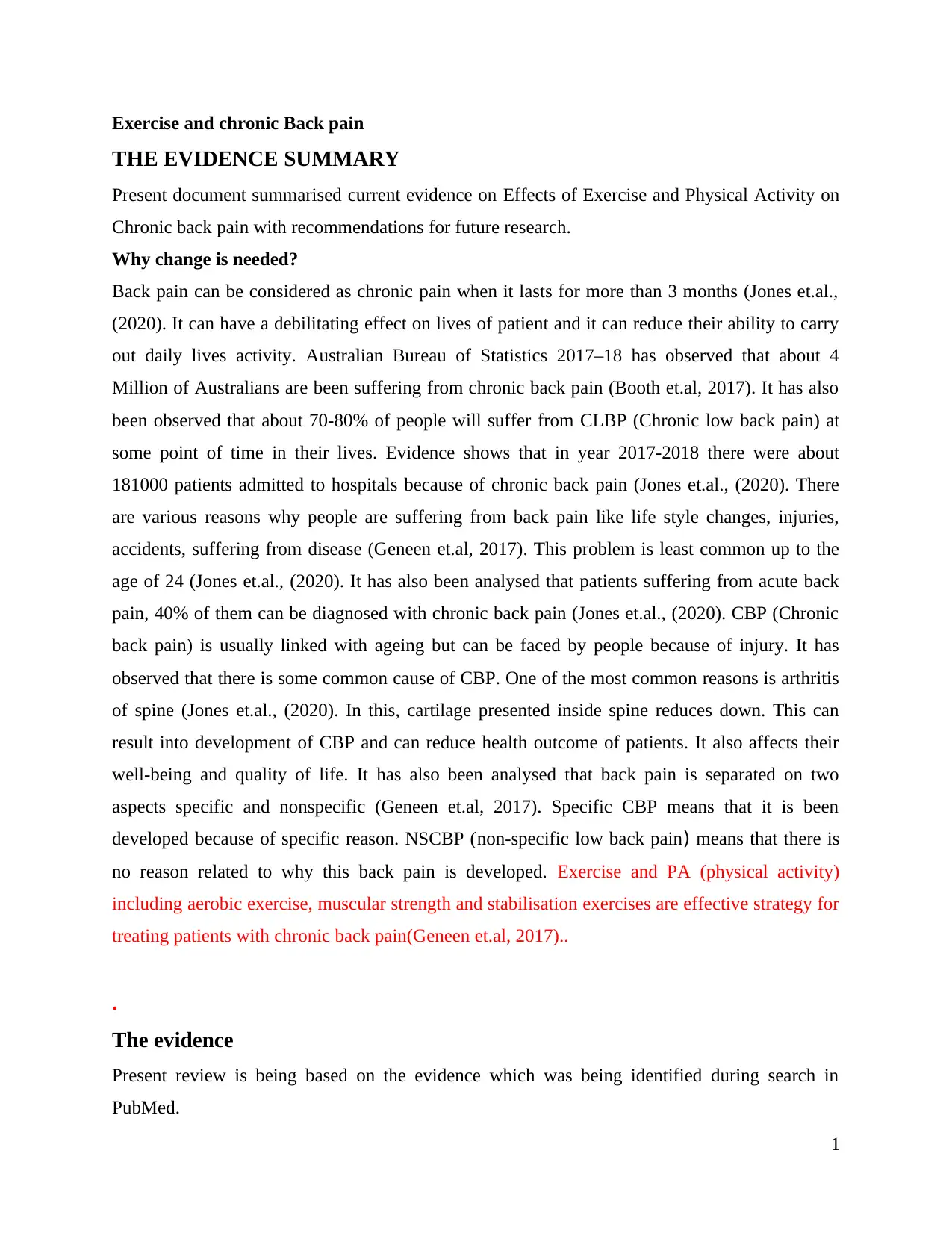
Exercise and chronic Back pain
THE EVIDENCE SUMMARY
Present document summarised current evidence on Effects of Exercise and Physical Activity on
Chronic back pain with recommendations for future research.
Why change is needed?
Back pain can be considered as chronic pain when it lasts for more than 3 months (Jones et.al.,
(2020). It can have a debilitating effect on lives of patient and it can reduce their ability to carry
out daily lives activity. Australian Bureau of Statistics 2017–18 has observed that about 4
Million of Australians are been suffering from chronic back pain (Booth et.al, 2017). It has also
been observed that about 70-80% of people will suffer from CLBP (Chronic low back pain) at
some point of time in their lives. Evidence shows that in year 2017-2018 there were about
181000 patients admitted to hospitals because of chronic back pain (Jones et.al., (2020). There
are various reasons why people are suffering from back pain like life style changes, injuries,
accidents, suffering from disease (Geneen et.al, 2017). This problem is least common up to the
age of 24 (Jones et.al., (2020). It has also been analysed that patients suffering from acute back
pain, 40% of them can be diagnosed with chronic back pain (Jones et.al., (2020). CBP (Chronic
back pain) is usually linked with ageing but can be faced by people because of injury. It has
observed that there is some common cause of CBP. One of the most common reasons is arthritis
of spine (Jones et.al., (2020). In this, cartilage presented inside spine reduces down. This can
result into development of CBP and can reduce health outcome of patients. It also affects their
well-being and quality of life. It has also been analysed that back pain is separated on two
aspects specific and nonspecific (Geneen et.al, 2017). Specific CBP means that it is been
developed because of specific reason. NSCBP (non-specific low back pain) means that there is
no reason related to why this back pain is developed. Exercise and PA (physical activity)
including aerobic exercise, muscular strength and stabilisation exercises are effective strategy for
treating patients with chronic back pain(Geneen et.al, 2017)..
.
The evidence
Present review is being based on the evidence which was being identified during search in
PubMed.
1
THE EVIDENCE SUMMARY
Present document summarised current evidence on Effects of Exercise and Physical Activity on
Chronic back pain with recommendations for future research.
Why change is needed?
Back pain can be considered as chronic pain when it lasts for more than 3 months (Jones et.al.,
(2020). It can have a debilitating effect on lives of patient and it can reduce their ability to carry
out daily lives activity. Australian Bureau of Statistics 2017–18 has observed that about 4
Million of Australians are been suffering from chronic back pain (Booth et.al, 2017). It has also
been observed that about 70-80% of people will suffer from CLBP (Chronic low back pain) at
some point of time in their lives. Evidence shows that in year 2017-2018 there were about
181000 patients admitted to hospitals because of chronic back pain (Jones et.al., (2020). There
are various reasons why people are suffering from back pain like life style changes, injuries,
accidents, suffering from disease (Geneen et.al, 2017). This problem is least common up to the
age of 24 (Jones et.al., (2020). It has also been analysed that patients suffering from acute back
pain, 40% of them can be diagnosed with chronic back pain (Jones et.al., (2020). CBP (Chronic
back pain) is usually linked with ageing but can be faced by people because of injury. It has
observed that there is some common cause of CBP. One of the most common reasons is arthritis
of spine (Jones et.al., (2020). In this, cartilage presented inside spine reduces down. This can
result into development of CBP and can reduce health outcome of patients. It also affects their
well-being and quality of life. It has also been analysed that back pain is separated on two
aspects specific and nonspecific (Geneen et.al, 2017). Specific CBP means that it is been
developed because of specific reason. NSCBP (non-specific low back pain) means that there is
no reason related to why this back pain is developed. Exercise and PA (physical activity)
including aerobic exercise, muscular strength and stabilisation exercises are effective strategy for
treating patients with chronic back pain(Geneen et.al, 2017)..
.
The evidence
Present review is being based on the evidence which was being identified during search in
PubMed.
1
Paraphrase This Document
Need a fresh take? Get an instant paraphrase of this document with our AI Paraphraser
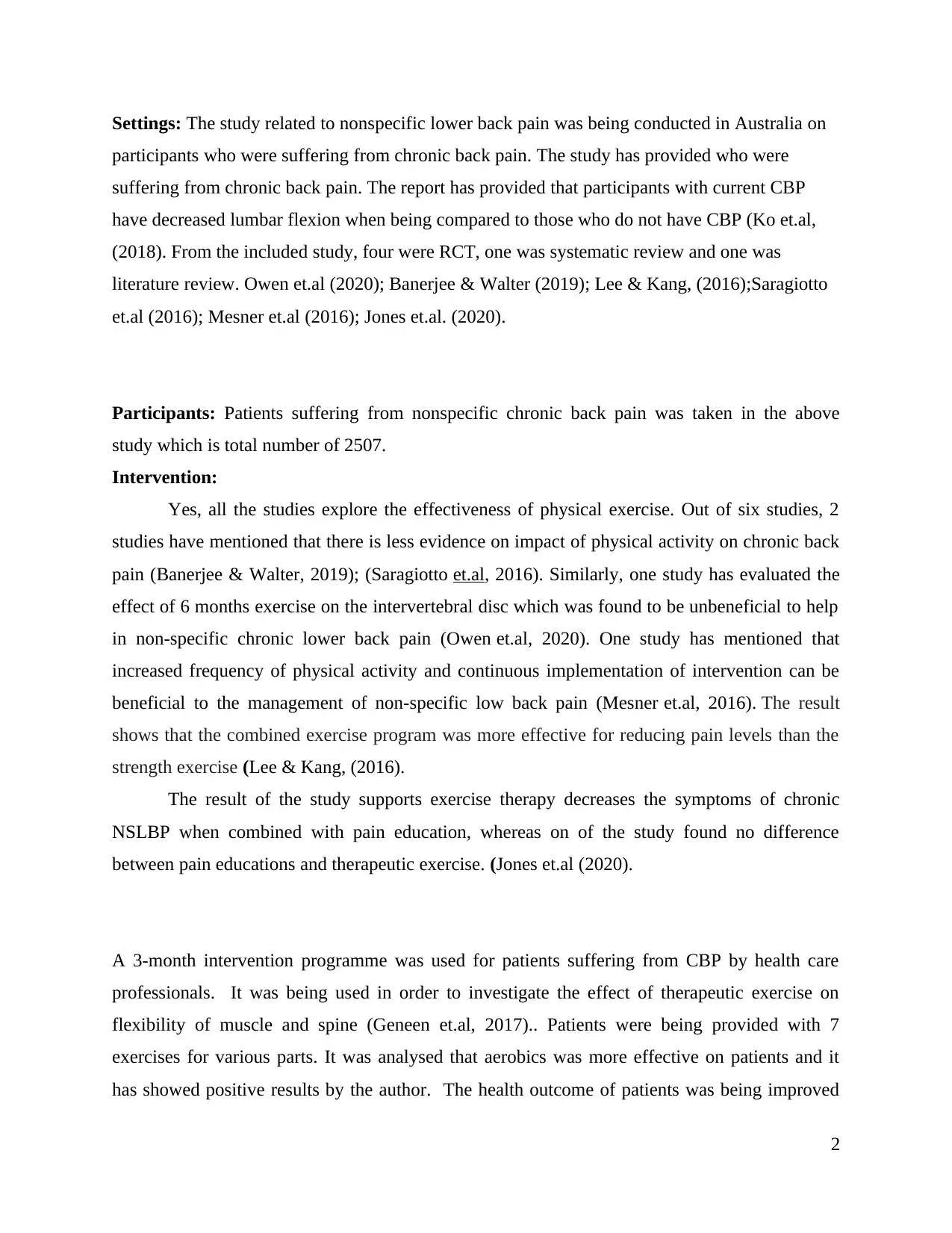
Settings: The study related to nonspecific lower back pain was being conducted in Australia on
participants who were suffering from chronic back pain. The study has provided who were
suffering from chronic back pain. The report has provided that participants with current CBP
have decreased lumbar flexion when being compared to those who do not have CBP (Ko et.al,
(2018). From the included study, four were RCT, one was systematic review and one was
literature review. Owen et.al (2020); Banerjee & Walter (2019); Lee & Kang, (2016);Saragiotto
et.al (2016); Mesner et.al (2016); Jones et.al. (2020).
Participants: Patients suffering from nonspecific chronic back pain was taken in the above
study which is total number of 2507.
Intervention:
Yes, all the studies explore the effectiveness of physical exercise. Out of six studies, 2
studies have mentioned that there is less evidence on impact of physical activity on chronic back
pain (Banerjee & Walter, 2019); (Saragiotto et.al, 2016). Similarly, one study has evaluated the
effect of 6 months exercise on the intervertebral disc which was found to be unbeneficial to help
in non-specific chronic lower back pain (Owen et.al, 2020). One study has mentioned that
increased frequency of physical activity and continuous implementation of intervention can be
beneficial to the management of non-specific low back pain (Mesner et.al, 2016). The result
shows that the combined exercise program was more effective for reducing pain levels than the
strength exercise (Lee & Kang, (2016).
The result of the study supports exercise therapy decreases the symptoms of chronic
NSLBP when combined with pain education, whereas on of the study found no difference
between pain educations and therapeutic exercise. (Jones et.al (2020).
A 3-month intervention programme was used for patients suffering from CBP by health care
professionals. It was being used in order to investigate the effect of therapeutic exercise on
flexibility of muscle and spine (Geneen et.al, 2017).. Patients were being provided with 7
exercises for various parts. It was analysed that aerobics was more effective on patients and it
has showed positive results by the author. The health outcome of patients was being improved
2
participants who were suffering from chronic back pain. The study has provided who were
suffering from chronic back pain. The report has provided that participants with current CBP
have decreased lumbar flexion when being compared to those who do not have CBP (Ko et.al,
(2018). From the included study, four were RCT, one was systematic review and one was
literature review. Owen et.al (2020); Banerjee & Walter (2019); Lee & Kang, (2016);Saragiotto
et.al (2016); Mesner et.al (2016); Jones et.al. (2020).
Participants: Patients suffering from nonspecific chronic back pain was taken in the above
study which is total number of 2507.
Intervention:
Yes, all the studies explore the effectiveness of physical exercise. Out of six studies, 2
studies have mentioned that there is less evidence on impact of physical activity on chronic back
pain (Banerjee & Walter, 2019); (Saragiotto et.al, 2016). Similarly, one study has evaluated the
effect of 6 months exercise on the intervertebral disc which was found to be unbeneficial to help
in non-specific chronic lower back pain (Owen et.al, 2020). One study has mentioned that
increased frequency of physical activity and continuous implementation of intervention can be
beneficial to the management of non-specific low back pain (Mesner et.al, 2016). The result
shows that the combined exercise program was more effective for reducing pain levels than the
strength exercise (Lee & Kang, (2016).
The result of the study supports exercise therapy decreases the symptoms of chronic
NSLBP when combined with pain education, whereas on of the study found no difference
between pain educations and therapeutic exercise. (Jones et.al (2020).
A 3-month intervention programme was used for patients suffering from CBP by health care
professionals. It was being used in order to investigate the effect of therapeutic exercise on
flexibility of muscle and spine (Geneen et.al, 2017).. Patients were being provided with 7
exercises for various parts. It was analysed that aerobics was more effective on patients and it
has showed positive results by the author. The health outcome of patients was being improved
2
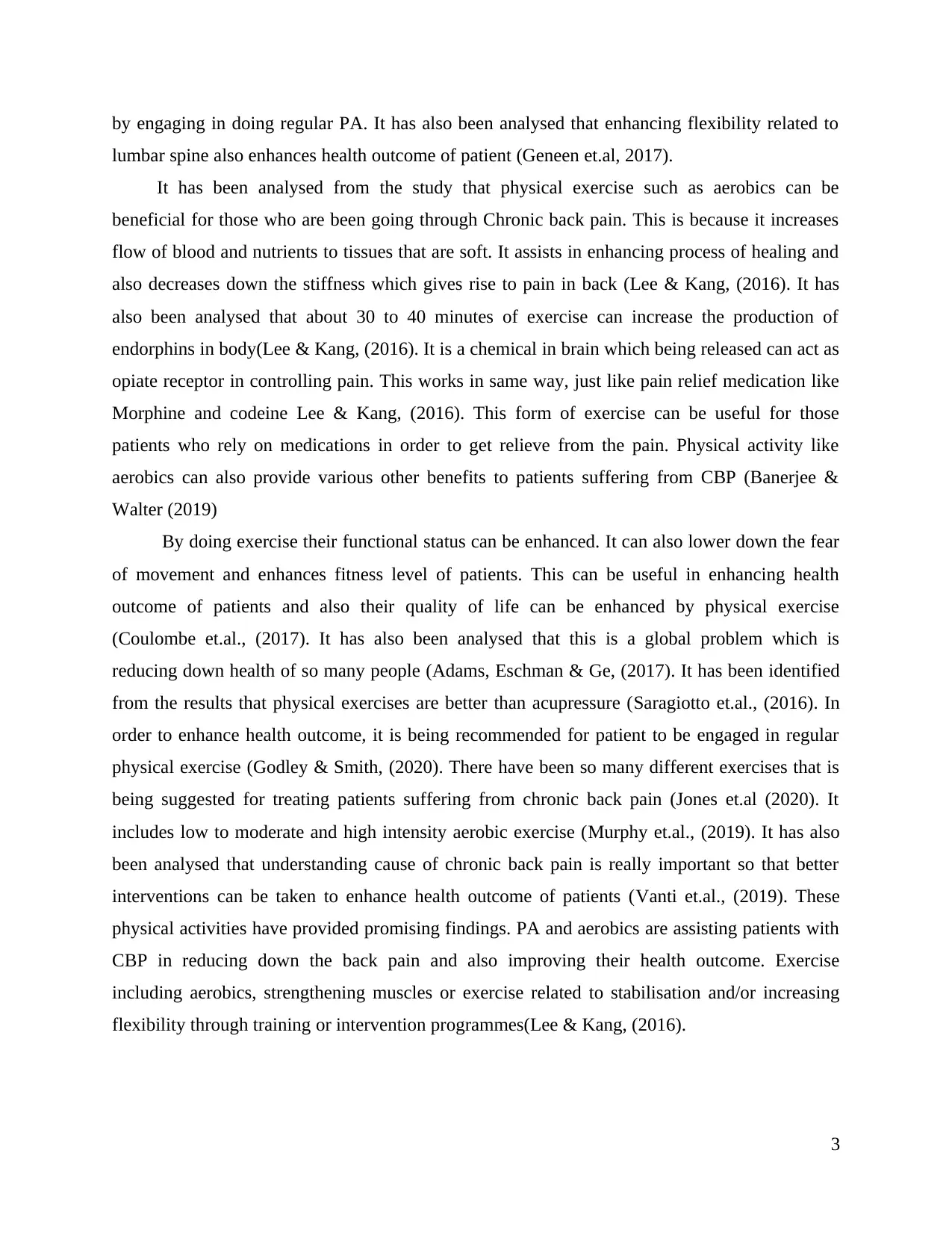
by engaging in doing regular PA. It has also been analysed that enhancing flexibility related to
lumbar spine also enhances health outcome of patient (Geneen et.al, 2017).
It has been analysed from the study that physical exercise such as aerobics can be
beneficial for those who are been going through Chronic back pain. This is because it increases
flow of blood and nutrients to tissues that are soft. It assists in enhancing process of healing and
also decreases down the stiffness which gives rise to pain in back (Lee & Kang, (2016). It has
also been analysed that about 30 to 40 minutes of exercise can increase the production of
endorphins in body(Lee & Kang, (2016). It is a chemical in brain which being released can act as
opiate receptor in controlling pain. This works in same way, just like pain relief medication like
Morphine and codeine Lee & Kang, (2016). This form of exercise can be useful for those
patients who rely on medications in order to get relieve from the pain. Physical activity like
aerobics can also provide various other benefits to patients suffering from CBP (Banerjee &
Walter (2019)
By doing exercise their functional status can be enhanced. It can also lower down the fear
of movement and enhances fitness level of patients. This can be useful in enhancing health
outcome of patients and also their quality of life can be enhanced by physical exercise
(Coulombe et.al., (2017). It has also been analysed that this is a global problem which is
reducing down health of so many people (Adams, Eschman & Ge, (2017). It has been identified
from the results that physical exercises are better than acupressure (Saragiotto et.al., (2016). In
order to enhance health outcome, it is being recommended for patient to be engaged in regular
physical exercise (Godley & Smith, (2020). There have been so many different exercises that is
being suggested for treating patients suffering from chronic back pain (Jones et.al (2020). It
includes low to moderate and high intensity aerobic exercise (Murphy et.al., (2019). It has also
been analysed that understanding cause of chronic back pain is really important so that better
interventions can be taken to enhance health outcome of patients (Vanti et.al., (2019). These
physical activities have provided promising findings. PA and aerobics are assisting patients with
CBP in reducing down the back pain and also improving their health outcome. Exercise
including aerobics, strengthening muscles or exercise related to stabilisation and/or increasing
flexibility through training or intervention programmes(Lee & Kang, (2016).
3
lumbar spine also enhances health outcome of patient (Geneen et.al, 2017).
It has been analysed from the study that physical exercise such as aerobics can be
beneficial for those who are been going through Chronic back pain. This is because it increases
flow of blood and nutrients to tissues that are soft. It assists in enhancing process of healing and
also decreases down the stiffness which gives rise to pain in back (Lee & Kang, (2016). It has
also been analysed that about 30 to 40 minutes of exercise can increase the production of
endorphins in body(Lee & Kang, (2016). It is a chemical in brain which being released can act as
opiate receptor in controlling pain. This works in same way, just like pain relief medication like
Morphine and codeine Lee & Kang, (2016). This form of exercise can be useful for those
patients who rely on medications in order to get relieve from the pain. Physical activity like
aerobics can also provide various other benefits to patients suffering from CBP (Banerjee &
Walter (2019)
By doing exercise their functional status can be enhanced. It can also lower down the fear
of movement and enhances fitness level of patients. This can be useful in enhancing health
outcome of patients and also their quality of life can be enhanced by physical exercise
(Coulombe et.al., (2017). It has also been analysed that this is a global problem which is
reducing down health of so many people (Adams, Eschman & Ge, (2017). It has been identified
from the results that physical exercises are better than acupressure (Saragiotto et.al., (2016). In
order to enhance health outcome, it is being recommended for patient to be engaged in regular
physical exercise (Godley & Smith, (2020). There have been so many different exercises that is
being suggested for treating patients suffering from chronic back pain (Jones et.al (2020). It
includes low to moderate and high intensity aerobic exercise (Murphy et.al., (2019). It has also
been analysed that understanding cause of chronic back pain is really important so that better
interventions can be taken to enhance health outcome of patients (Vanti et.al., (2019). These
physical activities have provided promising findings. PA and aerobics are assisting patients with
CBP in reducing down the back pain and also improving their health outcome. Exercise
including aerobics, strengthening muscles or exercise related to stabilisation and/or increasing
flexibility through training or intervention programmes(Lee & Kang, (2016).
3
⊘ This is a preview!⊘
Do you want full access?
Subscribe today to unlock all pages.

Trusted by 1+ million students worldwide
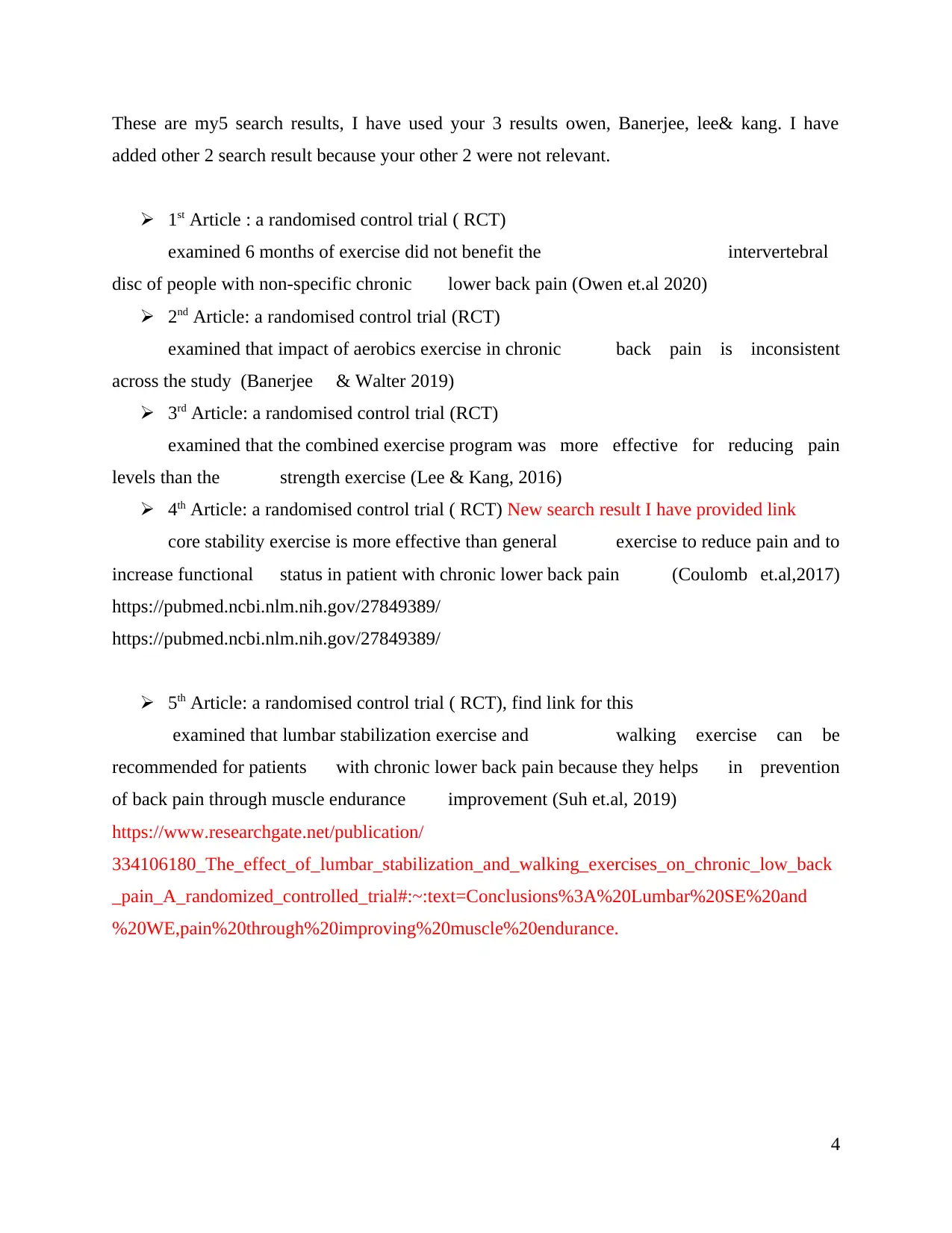
These are my5 search results, I have used your 3 results owen, Banerjee, lee& kang. I have
added other 2 search result because your other 2 were not relevant.
1st Article : a randomised control trial ( RCT)
examined 6 months of exercise did not benefit the intervertebral
disc of people with non-specific chronic lower back pain (Owen et.al 2020)
2nd Article: a randomised control trial (RCT)
examined that impact of aerobics exercise in chronic back pain is inconsistent
across the study (Banerjee & Walter 2019)
3rd Article: a randomised control trial (RCT)
examined that the combined exercise program was more effective for reducing pain
levels than the strength exercise (Lee & Kang, 2016)
4th Article: a randomised control trial ( RCT) New search result I have provided link
core stability exercise is more effective than general exercise to reduce pain and to
increase functional status in patient with chronic lower back pain (Coulomb et.al,2017)
https://pubmed.ncbi.nlm.nih.gov/27849389/
https://pubmed.ncbi.nlm.nih.gov/27849389/
5th Article: a randomised control trial ( RCT), find link for this
examined that lumbar stabilization exercise and walking exercise can be
recommended for patients with chronic lower back pain because they helps in prevention
of back pain through muscle endurance improvement (Suh et.al, 2019)
https://www.researchgate.net/publication/
334106180_The_effect_of_lumbar_stabilization_and_walking_exercises_on_chronic_low_back
_pain_A_randomized_controlled_trial#:~:text=Conclusions%3A%20Lumbar%20SE%20and
%20WE,pain%20through%20improving%20muscle%20endurance.
4
added other 2 search result because your other 2 were not relevant.
1st Article : a randomised control trial ( RCT)
examined 6 months of exercise did not benefit the intervertebral
disc of people with non-specific chronic lower back pain (Owen et.al 2020)
2nd Article: a randomised control trial (RCT)
examined that impact of aerobics exercise in chronic back pain is inconsistent
across the study (Banerjee & Walter 2019)
3rd Article: a randomised control trial (RCT)
examined that the combined exercise program was more effective for reducing pain
levels than the strength exercise (Lee & Kang, 2016)
4th Article: a randomised control trial ( RCT) New search result I have provided link
core stability exercise is more effective than general exercise to reduce pain and to
increase functional status in patient with chronic lower back pain (Coulomb et.al,2017)
https://pubmed.ncbi.nlm.nih.gov/27849389/
https://pubmed.ncbi.nlm.nih.gov/27849389/
5th Article: a randomised control trial ( RCT), find link for this
examined that lumbar stabilization exercise and walking exercise can be
recommended for patients with chronic lower back pain because they helps in prevention
of back pain through muscle endurance improvement (Suh et.al, 2019)
https://www.researchgate.net/publication/
334106180_The_effect_of_lumbar_stabilization_and_walking_exercises_on_chronic_low_back
_pain_A_randomized_controlled_trial#:~:text=Conclusions%3A%20Lumbar%20SE%20and
%20WE,pain%20through%20improving%20muscle%20endurance.
4
Paraphrase This Document
Need a fresh take? Get an instant paraphrase of this document with our AI Paraphraser
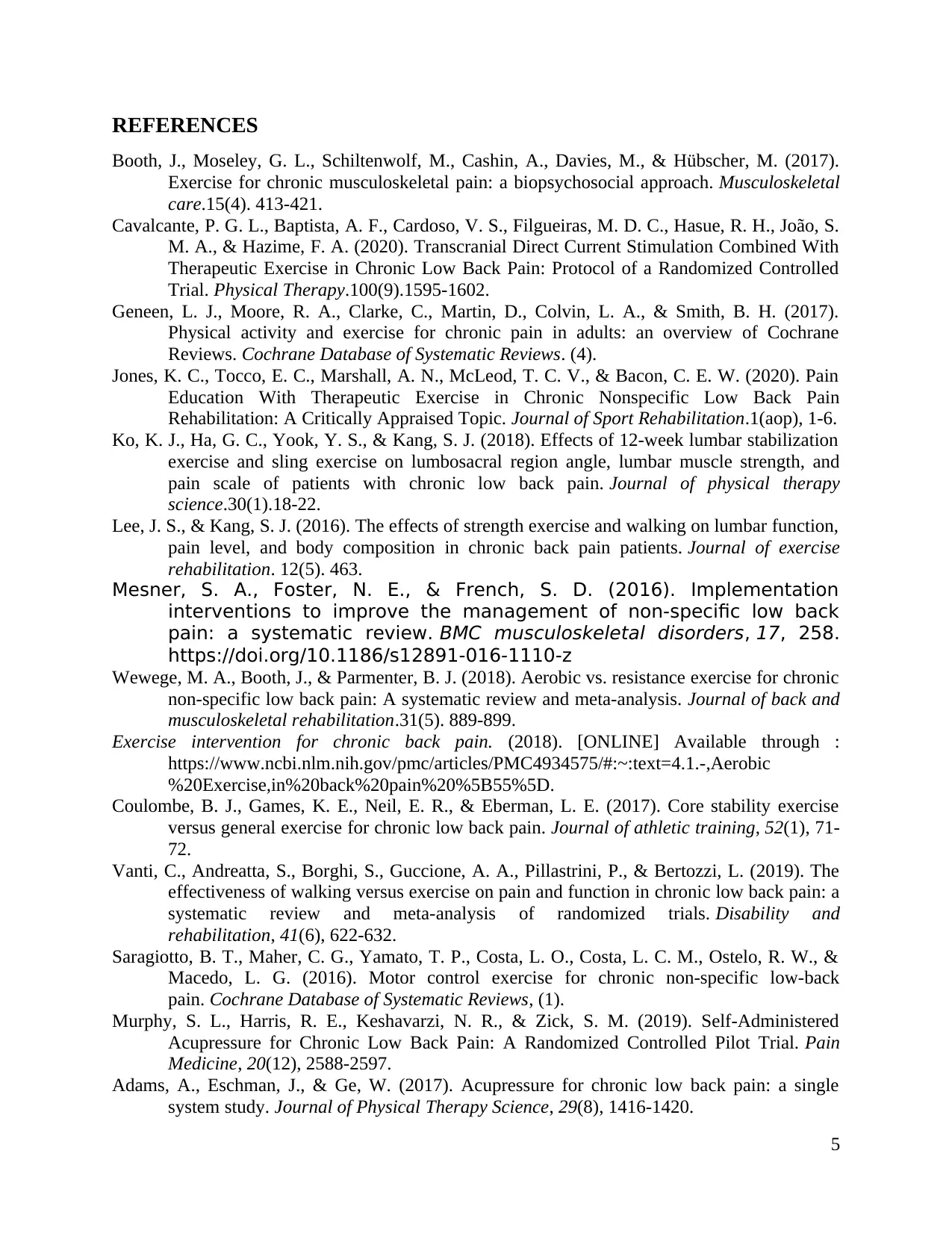
REFERENCES
Booth, J., Moseley, G. L., Schiltenwolf, M., Cashin, A., Davies, M., & Hübscher, M. (2017).
Exercise for chronic musculoskeletal pain: a biopsychosocial approach. Musculoskeletal
care.15(4). 413-421.
Cavalcante, P. G. L., Baptista, A. F., Cardoso, V. S., Filgueiras, M. D. C., Hasue, R. H., João, S.
M. A., & Hazime, F. A. (2020). Transcranial Direct Current Stimulation Combined With
Therapeutic Exercise in Chronic Low Back Pain: Protocol of a Randomized Controlled
Trial. Physical Therapy.100(9).1595-1602.
Geneen, L. J., Moore, R. A., Clarke, C., Martin, D., Colvin, L. A., & Smith, B. H. (2017).
Physical activity and exercise for chronic pain in adults: an overview of Cochrane
Reviews. Cochrane Database of Systematic Reviews. (4).
Jones, K. C., Tocco, E. C., Marshall, A. N., McLeod, T. C. V., & Bacon, C. E. W. (2020). Pain
Education With Therapeutic Exercise in Chronic Nonspecific Low Back Pain
Rehabilitation: A Critically Appraised Topic. Journal of Sport Rehabilitation.1(aop), 1-6.
Ko, K. J., Ha, G. C., Yook, Y. S., & Kang, S. J. (2018). Effects of 12-week lumbar stabilization
exercise and sling exercise on lumbosacral region angle, lumbar muscle strength, and
pain scale of patients with chronic low back pain. Journal of physical therapy
science.30(1).18-22.
Lee, J. S., & Kang, S. J. (2016). The effects of strength exercise and walking on lumbar function,
pain level, and body composition in chronic back pain patients. Journal of exercise
rehabilitation. 12(5). 463.
Mesner, S. A., Foster, N. E., & French, S. D. (2016). Implementation
interventions to improve the management of non-specific low back
pain: a systematic review. BMC musculoskeletal disorders, 17, 258.
https://doi.org/10.1186/s12891-016-1110-z
Wewege, M. A., Booth, J., & Parmenter, B. J. (2018). Aerobic vs. resistance exercise for chronic
non-specific low back pain: A systematic review and meta-analysis. Journal of back and
musculoskeletal rehabilitation.31(5). 889-899.
Exercise intervention for chronic back pain. (2018). [ONLINE] Available through :
https://www.ncbi.nlm.nih.gov/pmc/articles/PMC4934575/#:~:text=4.1.-,Aerobic
%20Exercise,in%20back%20pain%20%5B55%5D.
Coulombe, B. J., Games, K. E., Neil, E. R., & Eberman, L. E. (2017). Core stability exercise
versus general exercise for chronic low back pain. Journal of athletic training, 52(1), 71-
72.
Vanti, C., Andreatta, S., Borghi, S., Guccione, A. A., Pillastrini, P., & Bertozzi, L. (2019). The
effectiveness of walking versus exercise on pain and function in chronic low back pain: a
systematic review and meta-analysis of randomized trials. Disability and
rehabilitation, 41(6), 622-632.
Saragiotto, B. T., Maher, C. G., Yamato, T. P., Costa, L. O., Costa, L. C. M., Ostelo, R. W., &
Macedo, L. G. (2016). Motor control exercise for chronic non‐specific low‐back
pain. Cochrane Database of Systematic Reviews, (1).
Murphy, S. L., Harris, R. E., Keshavarzi, N. R., & Zick, S. M. (2019). Self-Administered
Acupressure for Chronic Low Back Pain: A Randomized Controlled Pilot Trial. Pain
Medicine, 20(12), 2588-2597.
Adams, A., Eschman, J., & Ge, W. (2017). Acupressure for chronic low back pain: a single
system study. Journal of Physical Therapy Science, 29(8), 1416-1420.
5
Booth, J., Moseley, G. L., Schiltenwolf, M., Cashin, A., Davies, M., & Hübscher, M. (2017).
Exercise for chronic musculoskeletal pain: a biopsychosocial approach. Musculoskeletal
care.15(4). 413-421.
Cavalcante, P. G. L., Baptista, A. F., Cardoso, V. S., Filgueiras, M. D. C., Hasue, R. H., João, S.
M. A., & Hazime, F. A. (2020). Transcranial Direct Current Stimulation Combined With
Therapeutic Exercise in Chronic Low Back Pain: Protocol of a Randomized Controlled
Trial. Physical Therapy.100(9).1595-1602.
Geneen, L. J., Moore, R. A., Clarke, C., Martin, D., Colvin, L. A., & Smith, B. H. (2017).
Physical activity and exercise for chronic pain in adults: an overview of Cochrane
Reviews. Cochrane Database of Systematic Reviews. (4).
Jones, K. C., Tocco, E. C., Marshall, A. N., McLeod, T. C. V., & Bacon, C. E. W. (2020). Pain
Education With Therapeutic Exercise in Chronic Nonspecific Low Back Pain
Rehabilitation: A Critically Appraised Topic. Journal of Sport Rehabilitation.1(aop), 1-6.
Ko, K. J., Ha, G. C., Yook, Y. S., & Kang, S. J. (2018). Effects of 12-week lumbar stabilization
exercise and sling exercise on lumbosacral region angle, lumbar muscle strength, and
pain scale of patients with chronic low back pain. Journal of physical therapy
science.30(1).18-22.
Lee, J. S., & Kang, S. J. (2016). The effects of strength exercise and walking on lumbar function,
pain level, and body composition in chronic back pain patients. Journal of exercise
rehabilitation. 12(5). 463.
Mesner, S. A., Foster, N. E., & French, S. D. (2016). Implementation
interventions to improve the management of non-specific low back
pain: a systematic review. BMC musculoskeletal disorders, 17, 258.
https://doi.org/10.1186/s12891-016-1110-z
Wewege, M. A., Booth, J., & Parmenter, B. J. (2018). Aerobic vs. resistance exercise for chronic
non-specific low back pain: A systematic review and meta-analysis. Journal of back and
musculoskeletal rehabilitation.31(5). 889-899.
Exercise intervention for chronic back pain. (2018). [ONLINE] Available through :
https://www.ncbi.nlm.nih.gov/pmc/articles/PMC4934575/#:~:text=4.1.-,Aerobic
%20Exercise,in%20back%20pain%20%5B55%5D.
Coulombe, B. J., Games, K. E., Neil, E. R., & Eberman, L. E. (2017). Core stability exercise
versus general exercise for chronic low back pain. Journal of athletic training, 52(1), 71-
72.
Vanti, C., Andreatta, S., Borghi, S., Guccione, A. A., Pillastrini, P., & Bertozzi, L. (2019). The
effectiveness of walking versus exercise on pain and function in chronic low back pain: a
systematic review and meta-analysis of randomized trials. Disability and
rehabilitation, 41(6), 622-632.
Saragiotto, B. T., Maher, C. G., Yamato, T. P., Costa, L. O., Costa, L. C. M., Ostelo, R. W., &
Macedo, L. G. (2016). Motor control exercise for chronic non‐specific low‐back
pain. Cochrane Database of Systematic Reviews, (1).
Murphy, S. L., Harris, R. E., Keshavarzi, N. R., & Zick, S. M. (2019). Self-Administered
Acupressure for Chronic Low Back Pain: A Randomized Controlled Pilot Trial. Pain
Medicine, 20(12), 2588-2597.
Adams, A., Eschman, J., & Ge, W. (2017). Acupressure for chronic low back pain: a single
system study. Journal of Physical Therapy Science, 29(8), 1416-1420.
5

Godley, E., & Smith, M. A. (2020). Efficacy of acupressure for chronic low back pain: A
systematic review. Complementary Therapies in Clinical Practice, 101146.
6
systematic review. Complementary Therapies in Clinical Practice, 101146.
6
⊘ This is a preview!⊘
Do you want full access?
Subscribe today to unlock all pages.

Trusted by 1+ million students worldwide
1 out of 6
Related Documents
Your All-in-One AI-Powered Toolkit for Academic Success.
+13062052269
info@desklib.com
Available 24*7 on WhatsApp / Email
![[object Object]](/_next/static/media/star-bottom.7253800d.svg)
Unlock your academic potential
Copyright © 2020–2025 A2Z Services. All Rights Reserved. Developed and managed by ZUCOL.




